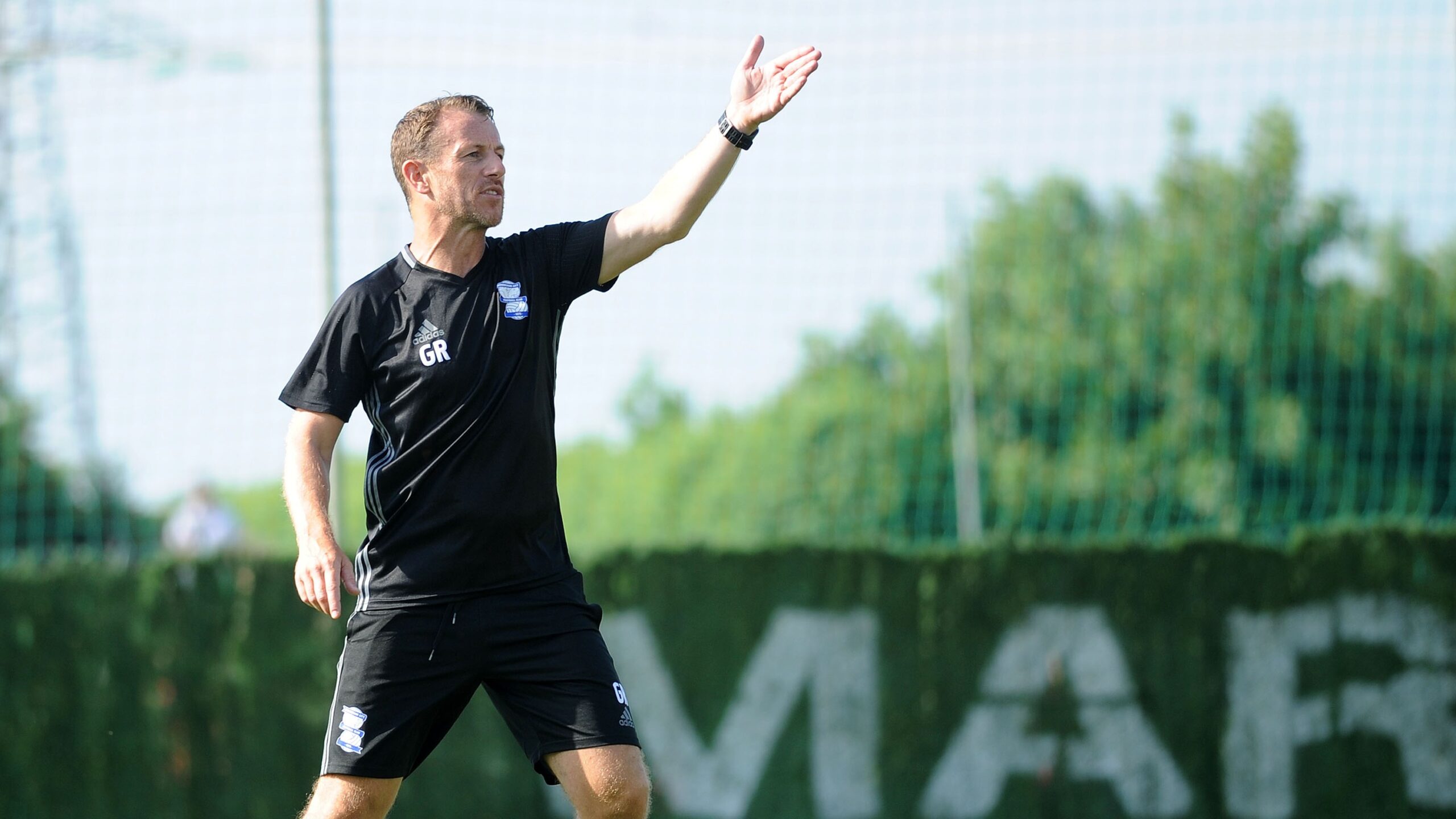Birmingham City opponent insight: Oxford United
Gary Rowett seeking to stifle Blues on St. Andrew’s return.
Contents:
•Introduction
•Predicted line-ups
•Areas to exploit
•Threats to be wary of
•Player to watch
•Prediction
Chris Davies may have felt a sense of vindication in last weekend’s late turnaround. The Blues boss was rightly frustrated with the penalty decision against Ipswich Town, and he’ll feel the points have evened themselves out after two weeks.
Blues weren’t at their flying best at Ewood Park, a ground where they’ve notoriously struggled to get over the line, but that’s where they differed this time. How often previously would that game have dwindled out, would Blues have squandered any momentum and come away 1-0 or 2-0 losers? But they didn’t.
Next on the bill for the Blues boss is a more familiar challenge. Oxford United stylistically are probably the closest test to the League One sides who challenged last season’s Champions to break them down . They’ve averaged the lowest possession so far this season, with just 25% against Hull City on Sunday.
So with a new look attacking line-up, can the hosts find the solutions that saw them victorious at St. Andrew’s so often last campaign?
In terms of the teams, Rowett has got one hand behind his back in some ways. Big money recruits Ole Romeny and Brian De Keersmaecker are both sidelined after a disastrous pre-season in Indonesia. Luke Harris is also unavailable whilst last year’s Player of the Season Ciaran Brown is out too.
Will Lankshear has been a bright spark in the opening two weeks. Rowett did change to a 3-4-3 in the second half on Sunday with Siriki Dembele and Matthew Phillips playing which may be an option.
For Blues this may be the game where Tommy Doyle starts. His creativity could be key to unlocking the backline in tandem with Paik. If so I’d imagine Keshi Anderson drops out with Jay Stansfield moving to the left.
Predicted XIs:
Image 1
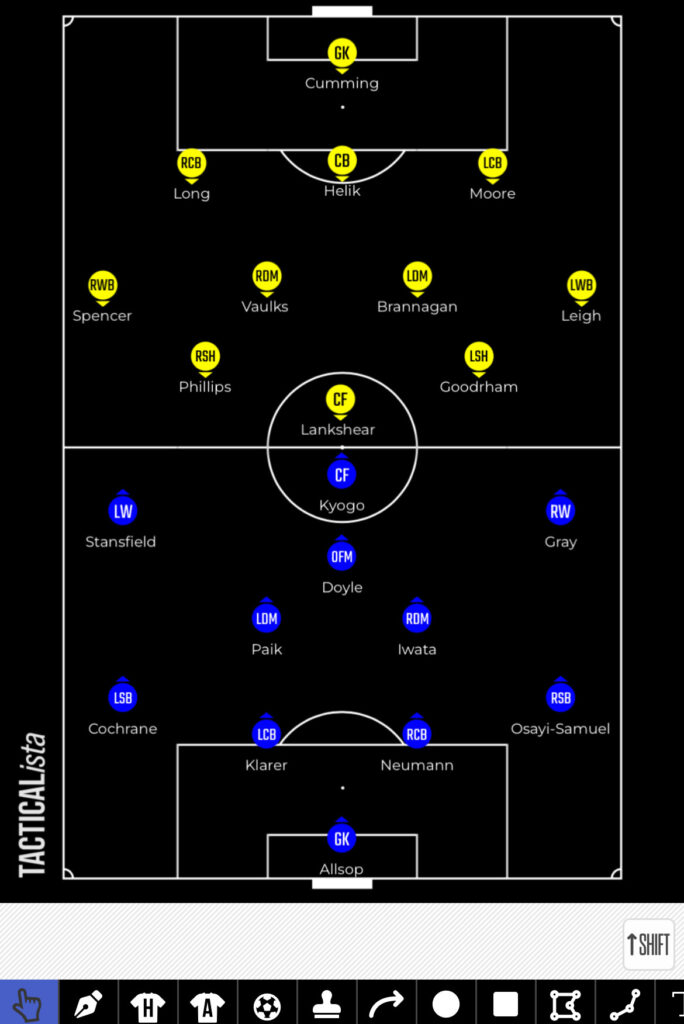
Areas to exploit:
•Creating gaps
•Positional weaknesses
Creating gaps:
Now as I mentioned Rowett is playing with personnel absences, which does hinder Oxford’s ability to defend in the way they’d ideally want to.
What struck me about the first two matches was just how easy Portsmouth and Hull found it to create huge channels of space in dangerous areas against the Yellows, with a few simple movements.
Image 2
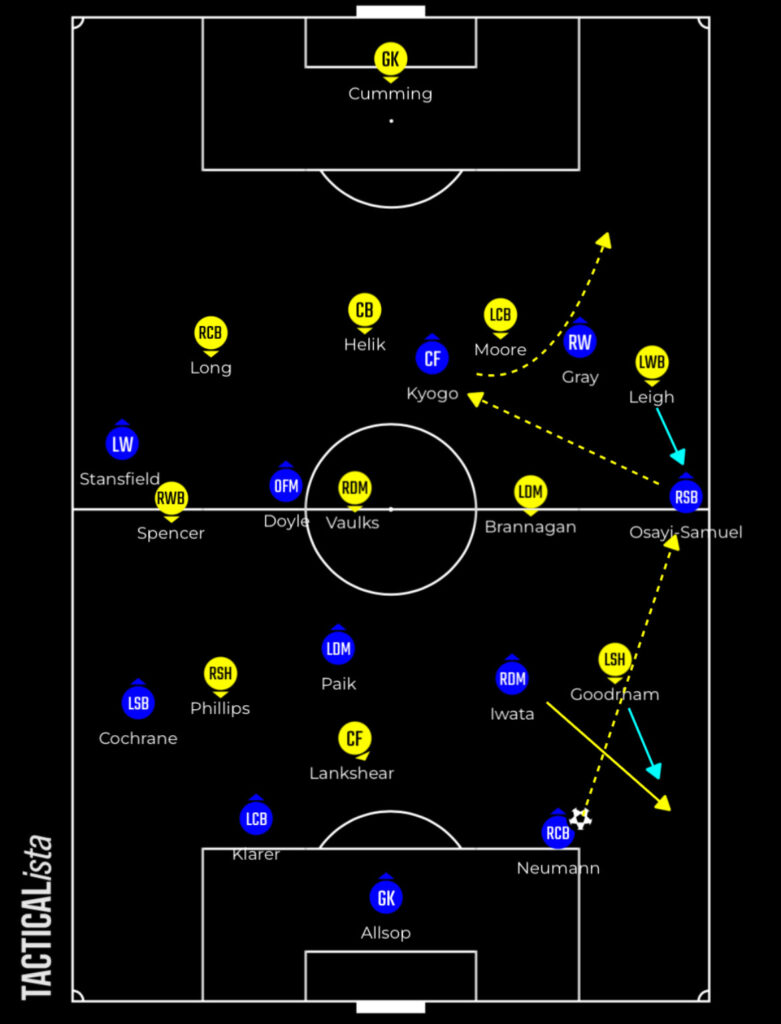
Matt Crook did exceptionally well for Hull’s first goal to capitalise on the shortcomings of the 4-4-2 system. With a two man midfield there’s always going to be a finite amount of space to cover (especially without tonnes of athleticism) and as such it limits the ability of those midfielders to follow their markers deep.
Crook recognises that and drops between the RCB and the RB to drag Tyler Goodrham (LW) towards him. This then leaves Greg Leigh with two men to watch (RB and RW) with the RB pushing up – something Blues do too. The clipped ball allows the RW to run in being Leigh whilst he jumps the RB with the ball.
A short bounce pass off Oli McBurnie, who’s come close, then opens up a huge channel of space down the left for Joe Gelhardt (RW) and he scores.
Blues could feasibly replicate this kind of attack with Bright Osayi-Samuel and Demarai Gray both tending to push high down the right. Kyogo or Doyle can act as the bounce pass player, with a short movement towards the ball.
Even if they shift to a 3-4-3 shape this issue still occurs as Phil Neumann can drift wider to entice the LW short, again leaving Leigh in a 2v1 scenario and without a LCB who’s comfortable stepping across- with both Michal Helik and Elliott Moore traditionally central CBs – they can’t cover the extra ground.
We saw this scenario for the thirdHull goal where the Hull LW consciously made a movement towards the byline, dragging the wide CB with him. This created a corridor of space between the RCB and CCB as McBurnie occupied the middle CB to stop him shifting across. A short give and go left Ryan Giles with a free run into the box and McBurnie scores.
These are scenarios where the lack of natural wide CBs are hurting Oxford. They’ll try and be compact to minimise these openings but there will be times where Blues combinations force them to put pressure on the ball and ball player.
Oxford are lacking pace at CB with Brown out and they’re lacking mobility in the centre of the park, with neither Cameron Brannagan nor Will Vaulks blessed as a ground covering midfielder.
Blues’ play will need to be short and sharp, and players will need to attack the vacant spaces. Players like Doyle and Paik are perfect in these situations as they have the vision to see the passes before the emerge.
On the left hand side, whether it’s Anderson or Stansfield, they could have a really key role at unlocking Paik when he makes forward runs. In both of their first two games there were times where the RB/RWB came across to the touchline and a chasm of space formed behind them with the midfielders unable to quickly drop in and plug the gaps. That’s where Blues could thrive.
Positional weaknesses:
Now I have talked about these positional issues in the first section but I do feel they need focusing on. When Oxford are short of numbers at the back they often lack the positional reading to stop attacks.
Image 3
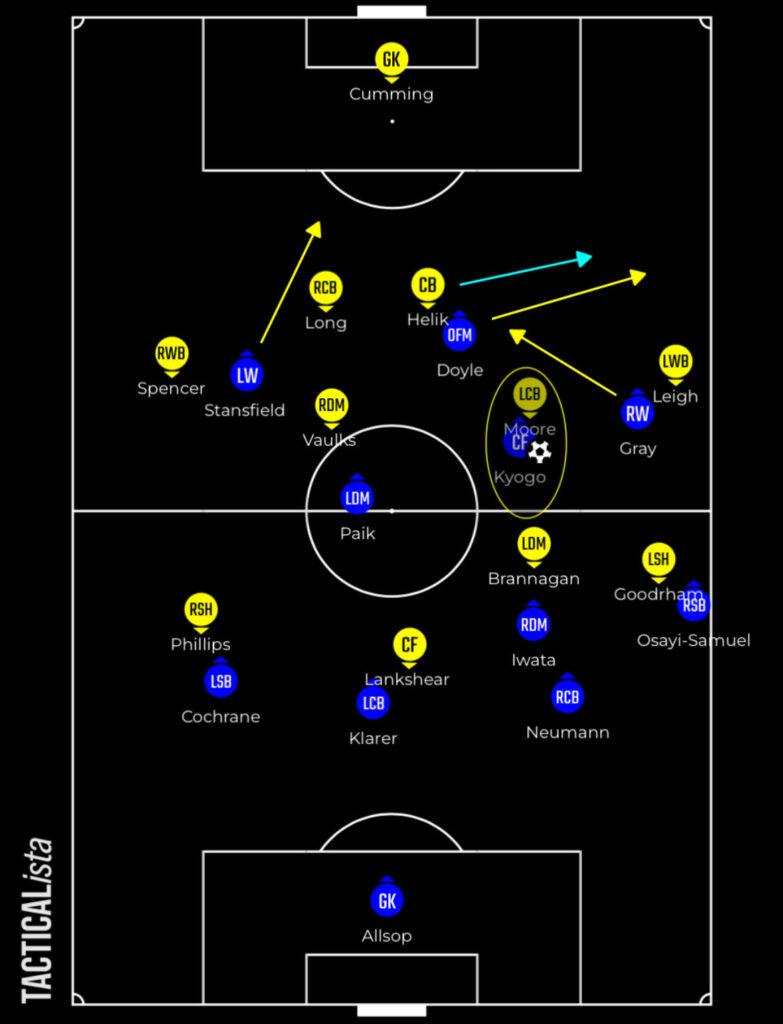
Leigh is a bit of a culprit for this. He’s not the most defensively sound LB and a lot of his good work comes towards the opposition goal.
In opposition build up play he can be drawn towards the ball, and when the ball is deep in Oxford territory he’s not always switched on at holding the line which can lead to him being run past.
As I mentioned Brown is out and he managed to patch over those shortcomings last season by covering the space but Moore and Helik are both quite robust, traditional CBs.
They’ve shown a tendency to be positionally aggressive in the challenge when the striker is dropping deep to receive the ball, either by instinct or by instruction, and this has created a pathway for opponents to threaten them.
When the ball goes into the strikers feet it’s usually as the midfield has been bypassed. The CMs are fairly flat out of possession and often struggle to pick up the loose ball from the striker as they’re challenged by one of the Oxford CBs.
As the opposition striker comes deep, the other forward or 10 – in Blues’ case Doyle or Stansfield – makes a diagonal movement towards the near touchline, with the deeper CB mirroring them. This either creates a big space between them and the far side full back, or it causes the full back to tuck in.
Opponents can then find their far side winger who’s either one v one with the full-back or has vacated space to attack with the full-back shifting across to tuck into the backline.
It’s again another kind of gap where Blues can hurt Oxford. Those spaces between the CBs, CMs and FBs are all vulnerable lately. There’s not a natural sweeper in the midfield who can release the other to be more tenacious, there’s not an available ground eating CB who can patch over Leigh’s weaknesses, and there’s not a player to support the far side FB.
Oxford’s natural inclination will be to sink deep, but Blues can draw them out in certain patterns, and that may be where we see success.
Threats to be wary of:
•Set piece danger
•Left side overlaps
Set piece danger:
I don’t like limiting managers by saying they rely on set pieces as there are so many elements to a game but Rowett’s sides are certainly amongst those that favour dead ball scenarios. Already this season we’ve seen how dangerous they can be from those hurled long throws in – I’m looking at you Vaulks and Jack Currie.
Oxford are a physical side, there’s no getting away from that. I’ve picked out the limitations of Elliott Moore and Helik’s game’s but each are colossal aerial forces. Leigh may not be the most positionally sound defender but he does have an effective leap and ability to sniff out goals. Mark Harris won’t return bundles of goals but he’s an outlet, whilst Will Lankshear can equally handle himself.
We’ve already seen Blues struggle to deal with set plays, both goals conceded so far have come as a result with the penalty against Ipswich and the failure to clear a Blackburn delivery last weekend.
Oxford will look to pile on the pressure when they get forward, although they perhaps need to be a bit more effective at translating their limited possession into crosses.
They’ve registered 10 shots on target already this season which shows that there are ways to threaten the opponent even with limited touches.
Already they’ve racked up the second most set piece xG whilst they’ve limited opponents to the sixth lowest set piece xG against. If it is Dembele and Phillips who come into the side there’s pace to counter from Blues’ own dead ball opportunities.
Helik is the standout threat. He’s scored 25 – yes that is TWENTY FIVE – goals in English football over a five-year stint. For a centre-back that’s pretty incredible, and he seems to be getting better with seven and nine goal returns in his last two seasons.
Blues have brought in some stature already this summer, with the imperious Neumann joining to partner Christoph Klarer and Osayi-Samuel adding a backbone that Ethan Laird may not provide, but to be enough to match this Oxford side will require some inventive thinking from the set piece team.
Left side overlaps:
If Oxford are to generate much from open play on Saturday, it’ll come down their left hand side. Again Leigh may not be the greatest defender in the world, but he does bring them a different dynamic to other full backs and that’s why he’s still in the side.
Image 4
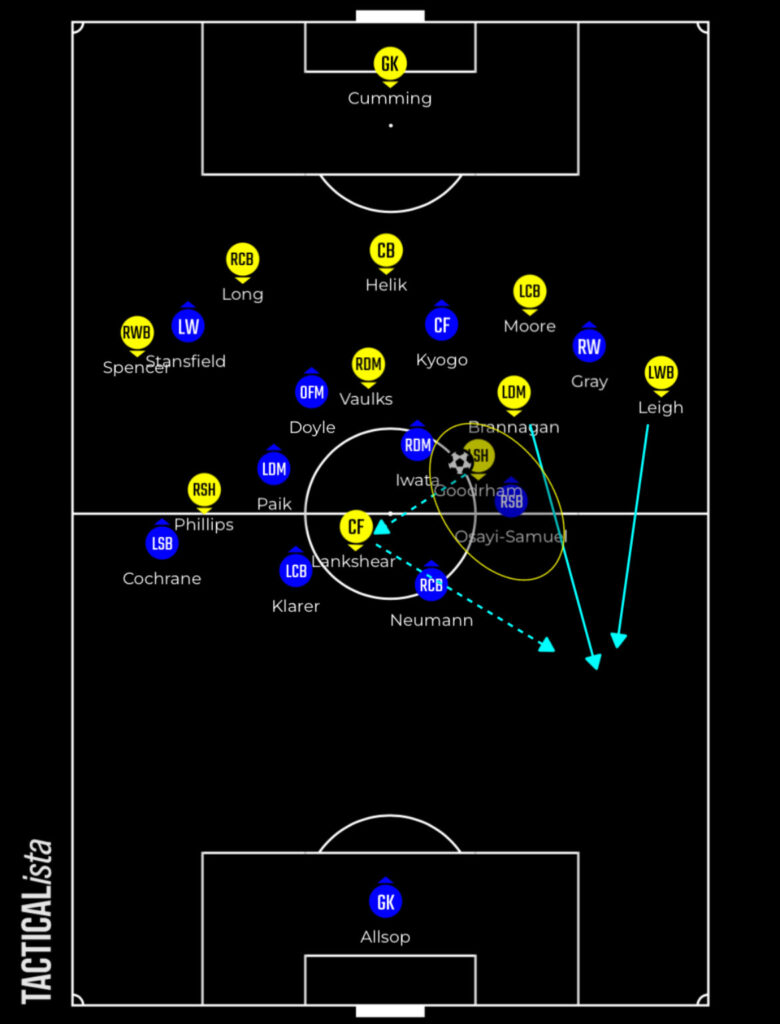
Leigh is so often the outlet, with Jamie Cumming persistently looking to clip the ball towards him down that left flank. Only one of Oxford’s successful long passes from Cumming have gone down the right hand side. Even if the ball isn’t aimed at him and is instead directed longer towards Goodrham, Leigh and Brannagan position themselves well to battle for the knock down.
Goodrham is almost the perfect partner for Leigh down the flank as not only does he work incredibly hard defensively to make sure he’s supported, he also loves to drift infield and give Leigh space to roam. Whether it’s Leigh or Brannagan stepping forward from midfield, Goodrham creates space to attack.
We saw this against Pompey where he stepped infield when the ball was on the opposite flank and positioned himself well to receive a Lankshear knockdown. The right back followed him infield and then a bounce pass off of Lankshear allowed Brannagan to run freely down the left with the space vacated.
Either Osayi-Samuel or Laird will need to be wary of following him infield. They can pass him off to Tomoki Iwata or Paik as the Oxford midfield don’t tend to step too high due to the space they have to cover. Communication needs to be good for that reason.
Gray has shown a tireless work ethic so far and that’ll need to be something he does once more particularly when Oxford look to spring a counter attack. The left side will likely be a key outlet and both him and the RB need to be diligent in covering ground.
Key man – Will Lankshear

